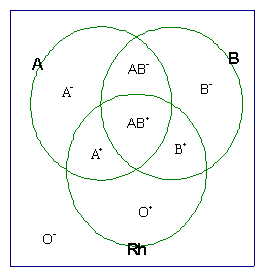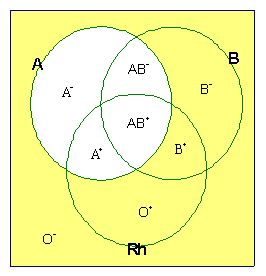Blood Types
from an article in the February 2002 Mathematics Teacher
by Vicki Young of Motlow State Community College
|
BACKGROUND This lesson involves human blood types. Although types O, A, B, and AB were first identified around 1900, anthropologists theorize that type O has existed since the advent of Cro-Magnon man approximately 40,000 years ago. Type A evolved from type O through a mutation in the red blood cells approximately 20,000 years ago. Type A red blood cells have an additional sugar molecule on the surface. A similar mutation caused the appearance of type B approximately 14,000 years ago. Type AB first appeared around 2,500 years ago. People with blood type AB have some red blood cells that include the A sugar molecule and some that have the B sugar molecule. The Rh factor, a protein found on the surface of some red blood cells, was discovered in 1940. Type O negative is called the universal donor because a transfusion introduces no additional A or B sugars or Rh protein into the recipient's bloodstream. Agglutination, or clumping, occurs when red blood cells of A, B, AB, or Rh positive blood are added to the bloodstream of a person whose red blood cells lack the protein or sugar. Researchers are seeking ways to remove the sugars and proteins from types A, B, AB, and O positive red blood cells to produce greater quantities of the universal donor. A compatible blood type is one that introduces no new elements into the recipient's bloodstream. The compatible families, or all blood types that can safely donate blood to a given blood type, can be determined by examining the Venn diagram shown in figure 1. The universe for the diagram is O negative, since all blood is either O negative or O negative with added sugars or proteins. The three overlapping circles represent blood types with the A sugar, the B sugar, and the Rh protein. The diagram has eight regions, one for each blood type. Using figure 1 and the definition of compatible blood types, you should determine all compatible blood types for each of the eight types and shade them in the diagrams below (B+ has been shaded for you).  figure 1 Figure 2 shows the compatible blood types for B+:
Now use the approximate blood-type percents, given in the table above,
to determine the theoretical probabilities for each blood type.
In other words, determine all the compatible blood types for a given type
(that is, the blood types that the given type can safely receive). Then
sum up the probabilites to determine what percent of the population could
donate blood to a person with that type. Remember, you don't want to
introduce any new sugars or proteins into that blood type.
|
